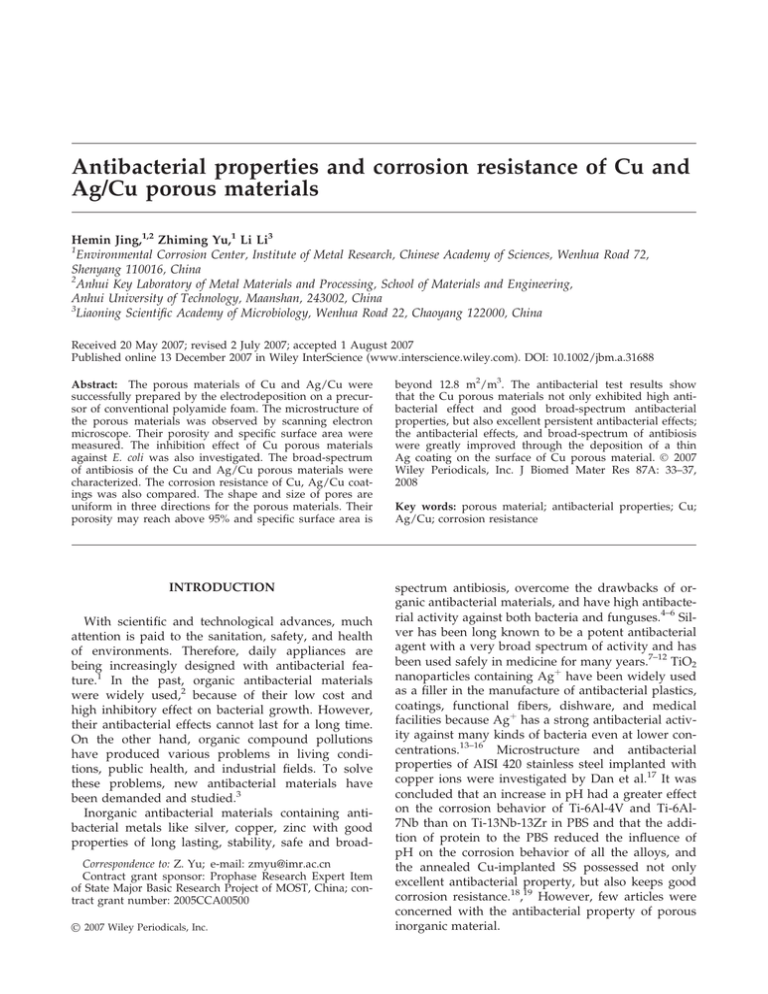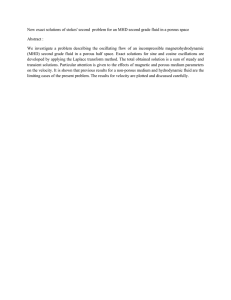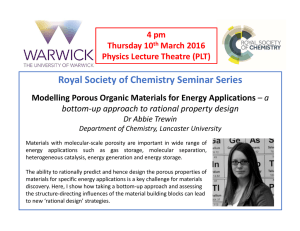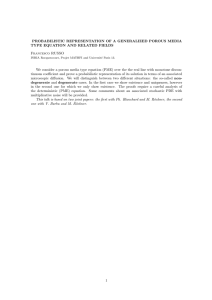Antibacterial properties and corrosion resistance of Cu and Ag/Cu
advertisement

Antibacterial properties and corrosion resistance of Cu and Ag/Cu porous materials Hemin Jing,1,2 Zhiming Yu,1 Li Li3 1 Environmental Corrosion Center, Institute of Metal Research, Chinese Academy of Sciences, Wenhua Road 72, Shenyang 110016, China 2 Anhui Key Laboratory of Metal Materials and Processing, School of Materials and Engineering, Anhui University of Technology, Maanshan, 243002, China 3 Liaoning Scientific Academy of Microbiology, Wenhua Road 22, Chaoyang 122000, China Received 20 May 2007; revised 2 July 2007; accepted 1 August 2007 Published online 13 December 2007 in Wiley InterScience (www.interscience.wiley.com). DOI: 10.1002/jbm.a.31688 Abstract: The porous materials of Cu and Ag/Cu were successfully prepared by the electrodeposition on a precursor of conventional polyamide foam. The microstructure of the porous materials was observed by scanning electron microscope. Their porosity and specific surface area were measured. The inhibition effect of Cu porous materials against E. coli was also investigated. The broad-spectrum of antibiosis of the Cu and Ag/Cu porous materials were characterized. The corrosion resistance of Cu, Ag/Cu coatings was also compared. The shape and size of pores are uniform in three directions for the porous materials. Their porosity may reach above 95% and specific surface area is beyond 12.8 m2/m3. The antibacterial test results show that the Cu porous materials not only exhibited high antibacterial effect and good broad-spectrum antibacterial properties, but also excellent persistent antibacterial effects; the antibacterial effects, and broad-spectrum of antibiosis were greatly improved through the deposition of a thin Ag coating on the surface of Cu porous material. Ó 2007 Wiley Periodicals, Inc. J Biomed Mater Res 87A: 33–37, 2008 INTRODUCTION spectrum antibiosis, overcome the drawbacks of organic antibacterial materials, and have high antibacterial activity against both bacteria and funguses.4–6 Silver has been long known to be a potent antibacterial agent with a very broad spectrum of activity and has been used safely in medicine for many years.7–12 TiO2 nanoparticles containing Agþ have been widely used as a filler in the manufacture of antibacterial plastics, coatings, functional fibers, dishware, and medical facilities because Agþ has a strong antibacterial activity against many kinds of bacteria even at lower concentrations.13–16 Microstructure and antibacterial properties of AISI 420 stainless steel implanted with copper ions were investigated by Dan et al.17 It was concluded that an increase in pH had a greater effect on the corrosion behavior of Ti-6Al-4V and Ti-6Al7Nb than on Ti-13Nb-13Zr in PBS and that the addition of protein to the PBS reduced the influence of pH on the corrosion behavior of all the alloys, and the annealed Cu-implanted SS possessed not only excellent antibacterial property, but also keeps good corrosion resistance.18,19 However, few articles were concerned with the antibacterial property of porous inorganic material. With scientific and technological advances, much attention is paid to the sanitation, safety, and health of environments. Therefore, daily appliances are being increasingly designed with antibacterial feature.1 In the past, organic antibacterial materials were widely used,2 because of their low cost and high inhibitory effect on bacterial growth. However, their antibacterial effects cannot last for a long time. On the other hand, organic compound pollutions have produced various problems in living conditions, public health, and industrial fields. To solve these problems, new antibacterial materials have been demanded and studied.3 Inorganic antibacterial materials containing antibacterial metals like silver, copper, zinc with good properties of long lasting, stability, safe and broadCorrespondence to: Z. Yu; e-mail: zmyu@imr.ac.cn Contract grant sponsor: Prophase Research Expert Item of State Major Basic Research Project of MOST, China; contract grant number: 2005CCA00500 Ó 2007 Wiley Periodicals, Inc. Key words: porous material; antibacterial properties; Cu; Ag/Cu; corrosion resistance 34 JING, YU, AND LI In this study, the microstructure of Cu porous material was observed, whose porosity and specific surface area were measured. The inhibition effect of Cuporous materials against E. coli was investigated. The broad-spectrum of antibiosis of the Cu and Ag/ Cu porous material were evaluated. The corrosion resistance of Cu and Ag/Cu coatings was discussed. EXPERIMENTAL PROCEDURE Preparation of materials Conventional foam of polyamide with thickness of about 2 mm was used as precursor material, for making the Cu porous materials. After conducting treatment, copper coatings with thickness of about 20 lm were deposited on the precursor by electroplating. Then, heat treatment was carried out at 7008C for 2 h in argon atmosphere. Moreover, Ag thin film of about 100 nm was coated on the surface of the Cu porous materials to expand its broadspectrum of antibiosis as well as to promote its antibacterial effect. The microstructure and the physical property The morphology images of the Cu porous materials were observed by scanning electron microscope (SEM). By comparing the mass of porous material with that of solid material, the porosity of the Cu porous materials was 0 determined. The porosity is given by e ¼ mm m 3 100% where e is the porosity, m is the mass of bulk material, and m0 is the mass of porous material. Specific surface area of the porous materials was measured by the permeation method, which is given by ffi qffiffiffiffiffiffiffiffiffiffiffiffiffiffiffiffi e3 ADP S ¼ 14 ð1e , where S is the specific surface area, e is Þ2 hdQ the porosity, A is the area of the porous materials for the permeation measurement D P is the press difference between the two sides, d is the thickness of the porous materials, h is the conglutination coefficient, and Q is the flux of nitrogen gas, which passes the porous materials. Antibacterial test Firstly, porous materials of Cu or Ag/Cu were prepared with the same exposed area of 20 mm 3 20 mm. For microbiological experimentation, Escherichia coli (ATCC 8099), Candida albicans (ATCC 10231), Staphylococcus aureus (ATCC 6538), Bacillus atrophaeus (ATCC 9372), and Saccharomyces cerevisiae (ATCC 18824) were selected as indicators. All glass wares (F110 mm) and samples were sterilized in autoclave at 1218C for 20 min before experiments. Test bacteria inoculated on beveled the nutrient agar medium plates were incubated at 378C for 24 h, whose store time is less than 30 days at 0–58C after incubation. The composition of mediums is shown in Table I. Before the antibacterial experiment, the aforementioned test bacteria were inoculated on an agar plate and incubated at 378C for 24 h. Each day, the test bacteria were inoculated one time within 2 weeks. The 0.2-mL of fresh bacteria solution was dripped onto the surface of specimen and then the specimen was put into the sterilized glass ware in which 5 mL of sterilized water was injected. After the specimen was cooled, 0.2 mL of bacterial was again dripped onto the surface of specimen and the specimen was covered with an aseptic polyethylene film to ensure that the bacterial solution was in close contact with the surface of the specimen. The specimen with the bacterial solution was incubated at 378C for 24 h. Subsequently, the number of bacterial colonies was counted. Each evaluation was carried out in triplicate and values obtained were averaged to given the final data. To evaluate the persistent antibacterial effects of Cu porous material, the used samples were used in the experiment which had been tested for 72 h. Before the experiment, the used samples were first ultrasonically cleaned for 10 min in acetone solution. The corrosion resistance of Cu and Ag/Cu coatings The SUS 304 stainless steel was used as the substrate material, whose dimension is 25 3 25 3 2 mm. Firstly, Cu film of about 15 lm was deposited on the substrate surface by electroplating. The samples coated with Cu film were divided into two groups. One group directly used to corrosion test; for another group, Ag film was deposited on the surface of Cu coating. Finally, the coated samples were TABLE I The Composition of the Mediums (g) Bacteria Composition Beef extract Peptone Yeast extract Glucose Sodium chloride Agar powder Potato Water Ph E coli (ATCC8099) 5 10 5 5 5 16 1000 mL 7.0 Journal of Biomedical Materials Research Part A S. aureus (ATCC6538) B. atrophaeus (ATCC9372) 3 5 3 5 5 16 5 16 1000 mL 7.0–7.2 1000 mL 7.0–7.2 C. albicans (ATCC10231) 20 16 200 1000 mL Natural ANTIBACTERIAL PROPERTIES AND CORROSION RESISTANCE OF Cu AND Ag/Cu prepared with the same exposed area. Polarization measurements were performed in 3.5% NaCl solution by means of the conventional electric cells with three electrodes on a 332 electrochemical measurement system (EG&G Princeton Applied Research) with a saturated calomel (SCE) reference electrode and a platinum counter electrode. All potentials are referred to SCE. Scanning rate was 5 mV/s. RESULTS AND DISCUSSION Microstructure and physical properties of Cu porous material Figure 1 shows the SEM image of the Cu porous material. It can be seen that the shape and size of pores is uniform in three directions, whose maximum diameter is about 0.6 mm. The calculation results show that the porosity is about 95%. The specific surface area is above 12.8 m2/m3. The specific surface area of Cu porous material is much higher than that of solid materials. Antibacterial performance Table II presents some results obtained by antibacterial tests against E. coli (3.5 3 106 cfu/mL) and S. aureus (1 3 106 cfu/mL), respectively. From the Table II, it follows that, the Cu porous material has very strong antibacterial activity against both E. coli and S. aureus. The percentage of dead cells reached 99.3% after 20-min incubation and 100% after only 40-min incubation; against S. aureus, the percentage of dead cells reached 98.4% after 20-min incubation, 99.3% after 40-min incubation, and 100% after 60-min incubation. The antibacterial effects of Cu porous material against S. aureus is worse than that of against E. coli. It may be attributed to the S. aureus a typical Gram-positive bac- 35 TABLE II The Antibacterial Effects of the Cu Porous Material Viable Cell Count (cfu/mL) Bacteria E. coli S. aureus Start 6 3.5 3 10 1.0 3 106 20 min 40 min 60 min 10 7 0 3 0 0 terium which has a thicker cell wall compared with E. coli a typical gram-negative bacterium. Moreover, Yamamoto and coworkers reported that both the percentages of dead cells reached 99% after 24-h incubation, by NASSAM3/#400 austenitic stainless steel containing Cu of 3.8% against E.coli with a start colony forming unit of 2.5 3 105 cfu/mL and against S. aureus with a start colony forming unit of 2.3 3 105 cfu/mL, respectively.20 It can be seen that the specific gravity of Cu porous material is less than 0.445 g/cm3, which is close to the Cu content (0.296 g/cm3) of the NASSAM3 austenitic stainless steel (0.04C-0.50Si-1.80Mn9.0Ni-18.0Cr-3.80Cu, wt%). However, the antibacterial activity of the former is greater than that of the latter, when against E. coli and S. aureus. It can be considered that the excellent antibacterial effect of the Cu porous material is due to its large surface area and high surface activity. Furthermore, from Table II, it can be seen that the viable cell count was seven after 20-min incubation, three after 40-min incubation and zero after 60min incubation, against S. aureus. The reason may be that the Cu2þ ions concentration was not enough to kill all S. aureus after 40-min incubation. This means that Cu2þ ions were slowly released into the medium from the Cu porous material. By contacting with 50 mL of 1 3 108, 1 3 109, and 1 3 1010 cfu/mL E. coli-containing water for 24 h, the persistent antibacterial effects of Cu porous material were evaluated and the results are shown in Table III. Table III shows that the Cu porous materials still have excellent antibacterial effects, which has been used for 72-h. Although the start colony forming unit is as high as 1 3 109 cfu/mL, the percentage of dead cells also reached 100% after 24-h incubation. It can be considered that the Cu porous material may be repeatedly used after proper cleanout. Table IV shows some results achieved by testing the inhibition effect of the Cu porous material against E.coli, S. aureus, C. albicans, and B. atrophaeus for 1, 6, and 24 hr. It can be seen that the Cu porous TABLE III The Persistent Antibacterial Effects of the Cu Porous Materials Against E. coli for 24 h Figure 1. The SEM image of the Cu porous material. Start (cfu/mL) 1 3 1010 1 3 109 1 3 108 Antibacterial rate (%) 96.5 100 100 Journal of Biomedical Materials Research Part A 36 JING, YU, AND LI TABLE IV The Broad-Spectrum of Antibiosis for the Cu Porous Material Antibacterial Rate (%) Bacteria E. coli S. aureus C. albicans B. atrophaeus TABLE VI The Antibacterial Effects of the Ag/Cu Porous Material Against S. cerevisiae (ATCC 18824) Start (cfu/mL) Antibacterial rate (%) 1 3 105 100 1 3 106 100 1 3 107 100 Start (cfu/mL) After 1 h After 6 h After 24 h 1.0 1.0 4.8 1.0 3 3 3 3 108 106 106 106 100 100 99.2 – 100 100 100 – 100 100 100 3.9 material has well broad-spectrum of antibiosis. For E.coli (1 3 108cfu/mL) and S. aureus (1.0 3 106 cfu/ mL) after 1 h, both of the percentage of dead cells reached 100%; for C. albicans (4.8 3 106 cfu/mL) after 6 h, the percentage of dead cells also reached 100%. However, the Cu porous material almost has not the inhibition effect against B. atrophaeus. From Table IV combining with Tables II and III, it is clear that the Cu porous materials not only exhibited high antibacterial effect and good broad-spectrum antibacterial properties, but also excellent persistent antibacterial effects. Table V shows the results achieved by testing the inhibition effect of the Ag/Cu porous material against E. coli, S. aureus, C. albicans, and B. atrophaeus after 1, 3, and 24-h incubation. From Tables IV and V, it can be seen that the Ag/Cu porous material has higher antibacterial effects and much better broad-spectrum of antibiosis than that of Cu porous material. Specially, it is evident the antibacterial properties against B. atrophaeus were greatly improved through the deposition of a thin Ag coating on the surface of Cu porous material, by comparison with Table IV. From the test results of Ag/ Cu porous material against B. atrophaeus after 1-h, 3-h and 24-h incubation, it can be seen that the percentage of dead cells gradually reaches 97% from 58% with prolonging the incubation time. This suggests that Agþ ions were slowly released into the medium from the Ag/Cu porous material. Combining with the aforementioned about the characteristic of Cu2þ release, it can be considered that the concentration of Agþ and Cu2þ in the processed liquid may be controlled at appropriate level by choosing proper contact time of the processed liquid with Cu or Ag/Cu porous material. The Ag/Cu porous materials possess high antibacterial effects and excellent broad-spectrum of antibiosis. The reason may be attributed to that the ionization energy (7.57 eV) of Agþ is much lower than that (20.29 eV) of Cu2þ. This means that the formation of Agþ ions is easier from silver than that of Cu2þ ions from copper. Therefore, Agþ ions easily interact with the cell wall, and then silver ions enter the cells and combined some cell components containing sulfur.21 Ag/Cu porous materials can be expected to have a promising application for a situation of strict sterility or high level disinfection. Moreover, the antibacterial effects of Ag/Cu porous material against S. cerevisiae (ATCC 18824) were evaluated and the results are shown in Table VI. From Table VI, it can be seen that the Ag/Cu porous material exhibited high antibacterial effect. When the start colony forming unit is as high as 1 3 107 cfu/ mL, the percentage of dead cells also reached 100% after 24-h incubation. If Ag/Cu porous material may be used to sterilize in the beer production process, a vast energy should be saved. Evaluation of the corrosion resistance of the porous materials Figure 2 shows the polarization curves of the Cu and Ag/Cu coatings in a solution of 3.5% NaCl. TABLE V The Broad-Spectrum of Antibiosis for the Ag/Cu Porous Material Antibacterial Rate (%) Bacteria E. coli S. aureus C. albicans B. atrophaeus Start (cfu/mL) After 1 h After 3 h After 24 h 1.5 5.6 2.0 5.0 3 3 3 3 108 107 108 108 100 100 100 58 Journal of Biomedical Materials Research Part A 100 100 100 76 100 100 100 97 Figure 2. Polarization curves of the Cu and Ag/Cu coatings in 3.5% NaCl solution. ANTIBACTERIAL PROPERTIES AND CORROSION RESISTANCE OF Cu AND Ag/Cu From Figure 2, it can be seen that the Cu coatings are not resistant to corrosion. The reason may be that a continuous passive film cannot be formed on the surface of Cu coating because Cu is not resistant to pitting corrosion in a solution that contains chlorides.22 By a comparison of the polarization curves of Cu coating and Ag/Cu coating, it can be found that a passivity maintaining zone exits in the polarization curve of Ag/Cu coating. It may be considered that the pit corrosion resistance was improved by a thin coating of Ag deposited on the Cu coating. However, it can be seen that the corrosion current of Ag/ Cu coating (Icorr 5 4.6 3 1026 A/cm2) is a little larger than that of Cu coating (Icorr 5 4.0 3 1026 A/ cm2). This means that the corrosion rate increased by a thin coating of Ag deposited on the Cu coating. Therefore, a detailed investigation is required to improve the corrosion resistance of Ag/Cu porous material. CONCLUSIONS 1. The Cu porous materials were successfully prepared by the electrodeposition on the foam of polyamide. Moreover, Ag/Cu porous materials were also obtained by coated a thin Ag film on the surface of the Cu porous material. 2. The Cu porous materials exhibited very strong antibacterial activity and the persistent antibacterial ability against E. coli. The percentage of dead cells already reached 100% on E. coli (3.5 3 106 cfu/mL) after 40-min incubation; although, the start colony forming unit is as high as 1 3 109 cfu/mL, the percentage of dead cells also reach 100% after 24-h incubation. 3. The Ag/Cu porous material has higher antibacterial effects and much better broad-spectrum of antibiosis than that of Cu porous material. Specially, it is evident that antibacterial properties against B. atrophaeus were greatly improved through the deposition of a thin Ag coating on the surface of Cu porous material. References 1. Hong IT, Koo CH. Antibacterial properties, corrosion resistance and mechanical properties of Cu-modified SUS 304 stainless steel. Mater Sci Eng A 2005;393:213–222. 37 2. Yokota T, Tochihara M. Kawasaki. Silver dispersed stainless steels with antibacterial property. Steel Rep 2001;33:88. 3. Kumar VS, Nagaraja BM, Shashikala V, Padmasri AH, Madhavendra SS, Raju BD, Rao KSR. Highly efficient Ag/C catalyst prepared by electrochemical deposition method in controlling microorganisms in water. J Mol Catal A: Chem 2004;223:313–319. 4. Modak SM, Fox CLJ. Binding of silver sulfadiazine to the cellular components of Pseudomonas aeruginous. Biochem Pharmacol 1973;22:2391. 5. Berger TJ, Spadaro JA, Chapin SE, Becker RO. Electrically generated silver ions: Quantitative effects on bacterial and mammalian cells. Antimicrob Agents Chemother 1976;9:357. 6. Williams RL, Doherty PJ, Vince DG, Grashoff GJ, Williams DF. The biocompatibility of silver. Crit Rev Biocompat 1989;5:221. 7. Ersek R. Silver impregnated porcine xenografts for treatment of meshed autografts. Ann Plast Surg 1984;13:325–330. 8. Hu C. Therapeutic effects of silver nylon dressings with weak direct current on Pseudomonas aeruginosa infected burn wounds. J Trauma 1988;28:1488–1492. 9. Liedberg H. Silver alloy coated catheters reduce catheterassociated bacteriuria. Br J Urol 1990:65:379–381. 10. Stamm W. Catheter-associated urinary tract infections: Epidemiology, pathogenesis and prevention. Am J Med 1991;91:65–71. 11. Johnson J. Prevention of catheter-associated urinary tract infection with asilver oxide coated urinary catheter: Clinical and microbiologic correlates. J Infect Dis 1990;162:1145–1150. 12. Babycos C. A prospective randomized trial comparing the silver-impregnated cuff with the bedside tunneled subclavian catheter. J Patenter Enteral Nutr 1993;17:61–63. 13. Zhang WZ, Wei WJ. A nover bactericide with silver ion. Rare Metal Mater Eng 1996;25:48–51. 14. Spadaro JA, Berger TJ, Barranco SD, Chapin SE, Becker RO. Antibacterial effects of silver electrodes with weak direct current. Antimicrob Agents Chemother 1974;6:637. 15. Zhang WZ. Review of Silver’s research and production. World Non-Ferrous Metals 1995;18:18–24. 16. Tomioko TS. Characteristics of antibacterial material ‘‘Amenitop’’ composed of silver complex. Nat Tech Rep 1994;40:39–45. 17. Dan ZG, Ni HW, Xu BF, Xiong J, Xiong PY. Microstructure and antibacterial properties of AISI 420 stainless steel implanted copper ions. Thin Solid Films 2005;492:93–100. 18. Trapalis CC, Kokkoris M, Perdikakis G, Kordas G. Study of antibacterial composite Cu/SiO2 thin coatings. J Sol-Gel Sci Technol 2003;26:1213–1218. 19. Khan MA, Williams RL, Williams DF. The corrosion behavior of Ti-6Al-4V, Ti-6Al-7Nb and Ti-13Nb-13Zr inprotein solutions. Biomaterials 1999;20:631–637. 20. Ookubo N, Nakamura S, Yamamoto M, Mikyakusu K, Hasegawa M, Munesue Y. Antimicrobial Activity and Basic Properties of Antimicrobial Stainless Steels ‘‘NSSAM Series’’. Nisshin Steel Rep 1998;77:69–81. 21. Feng QL, Wu J, Chen GQ, Cui FZ, Kim TN, Kim JO. A mechanistic study of the antibacterial effect of silver ions on Escherichia coli and Staphylococcus aureus. J Biomed Mater Res 2000;52:662–668. 22. Banas J, Mazurkiewicz A. The effect of copper on passivity and corrosion behavior of ferritic and ferritic-austenitic stainless steels. Mater Sci Eng A 2000;277:183. Journal of Biomedical Materials Research Part A





